Zhongjie Wang
Self-Critique Guided Iterative Reasoning for Multi-hop Question Answering
May 25, 2025Abstract:Although large language models (LLMs) have demonstrated remarkable reasoning capabilities, they still face challenges in knowledge-intensive multi-hop reasoning. Recent work explores iterative retrieval to address complex problems. However, the lack of intermediate guidance often results in inaccurate retrieval and flawed intermediate reasoning, leading to incorrect reasoning. To address these, we propose Self-Critique Guided Iterative Reasoning (SiGIR), which uses self-critique feedback to guide the iterative reasoning process. Specifically, through end-to-end training, we enable the model to iteratively address complex problems via question decomposition. Additionally, the model is able to self-evaluate its intermediate reasoning steps. During iterative reasoning, the model engages in branching exploration and employs self-evaluation to guide the selection of promising reasoning trajectories. Extensive experiments on three multi-hop reasoning datasets demonstrate the effectiveness of our proposed method, surpassing the previous SOTA by $8.6\%$. Furthermore, our thorough analysis offers insights for future research. Our code, data, and models are available at Github: https://github.com/zchuz/SiGIR-MHQA.
DUKAE: DUal-level Knowledge Accumulation and Ensemble for Pre-Trained Model-Based Continual Learning
Apr 09, 2025Abstract:Pre-trained model-based continual learning (PTMCL) has garnered growing attention, as it enables more rapid acquisition of new knowledge by leveraging the extensive foundational understanding inherent in pre-trained model (PTM). Most existing PTMCL methods use Parameter-Efficient Fine-Tuning (PEFT) to learn new knowledge while consolidating existing memory. However, they often face some challenges. A major challenge lies in the misalignment of classification heads, as the classification head of each task is trained within a distinct feature space, leading to inconsistent decision boundaries across tasks and, consequently, increased forgetting. Another critical limitation stems from the restricted feature-level knowledge accumulation, with feature learning typically restricted to the initial task only, which constrains the model's representation capabilities. To address these issues, we propose a method named DUal-level Knowledge Accumulation and Ensemble (DUKAE) that leverages both feature-level and decision-level knowledge accumulation by aligning classification heads into a unified feature space through Gaussian distribution sampling and introducing an adaptive expertise ensemble to fuse knowledge across feature subspaces.Extensive experiments on CIFAR-100, ImageNet-R, CUB-200, and Cars-196 datasets demonstrate the superior performance of our approach.
BeMERC: Behavior-Aware MLLM-based Framework for Multimodal Emotion Recognition in Conversation
Mar 31, 2025Abstract:Multimodal emotion recognition in conversation (MERC), the task of identifying the emotion label for each utterance in a conversation, is vital for developing empathetic machines. Current MLLM-based MERC studies focus mainly on capturing the speaker's textual or vocal characteristics, but ignore the significance of video-derived behavior information. Different from text and audio inputs, learning videos with rich facial expression, body language and posture, provides emotion trigger signals to the models for more accurate emotion predictions. In this paper, we propose a novel behavior-aware MLLM-based framework (BeMERC) to incorporate speaker's behaviors, including subtle facial micro-expression, body language and posture, into a vanilla MLLM-based MERC model, thereby facilitating the modeling of emotional dynamics during a conversation. Furthermore, BeMERC adopts a two-stage instruction tuning strategy to extend the model to the conversations scenario for end-to-end training of a MERC predictor. Experiments demonstrate that BeMERC achieves superior performance than the state-of-the-art methods on two benchmark datasets, and also provides a detailed discussion on the significance of video-derived behavior information in MERC.
Towards Unified Structured Light Optimization
Jan 24, 2025Abstract:Structured light (SL) 3D reconstruction captures the precise surface shape of objects, providing high-accuracy 3D data essential for industrial inspection and robotic vision systems. However, current research on optimizing projection patterns in SL 3D reconstruction faces two main limitations: each scene requires separate training of calibration parameters, and optimization is restricted to specific types of SL, which restricts their application range. To tackle these limitations, we present a unified framework for SL optimization, adaptable to diverse lighting conditions, object types, and different types of SL. Our framework quickly determines the optimal projection pattern using only a single projected image. Key contributions include a novel global matching method for projectors, enabling precise projector-camera alignment with just one projected image, and a new projection compensation model with a photometric adjustment module to reduce artifacts from out-of-gamut clipping. Experimental results show our method achieves superior decoding accuracy across various objects, SL patterns, and lighting conditions, significantly outperforming previous methods.
Scene Style Text Editing
Apr 20, 2023Abstract:In this work, we propose a task called "Scene Style Text Editing (SSTE)", changing the text content as well as the text style of the source image while keeping the original text scene. Existing methods neglect to fine-grained adjust the style of the foreground text, such as its rotation angle, color, and font type. To tackle this task, we propose a quadruple framework named "QuadNet" to embed and adjust foreground text styles in the latent feature space. Specifically, QuadNet consists of four parts, namely background inpainting, style encoder, content encoder, and fusion generator. The background inpainting erases the source text content and recovers the appropriate background with a highly authentic texture. The style encoder extracts the style embedding of the foreground text. The content encoder provides target text representations in the latent feature space to implement the content edits. The fusion generator combines the information yielded from the mentioned parts and generates the rendered text images. Practically, our method is capable of performing promisingly on real-world datasets with merely string-level annotation. To the best of our knowledge, our work is the first to finely manipulate the foreground text content and style by deeply semantic editing in the latent feature space. Extensive experiments demonstrate that QuadNet has the ability to generate photo-realistic foreground text and avoid source text shadows in real-world scenes when editing text content.
A Survey on Deep Neural Network Partition over Cloud, Edge and End Devices
Apr 20, 2023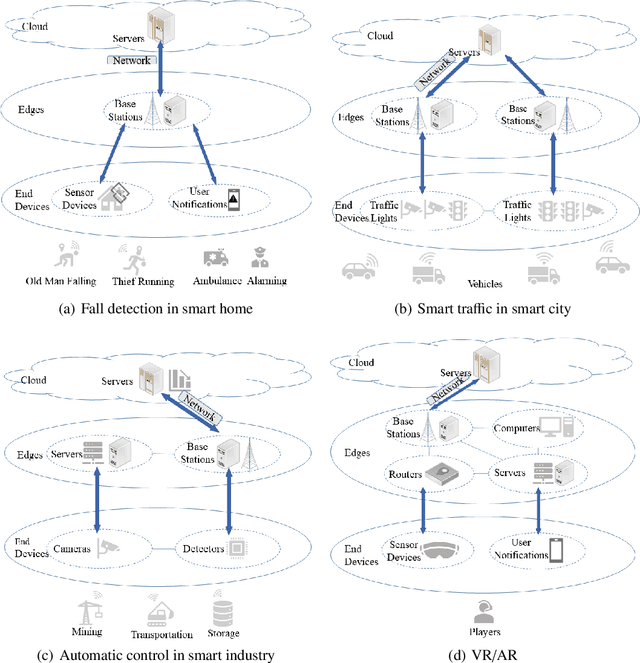
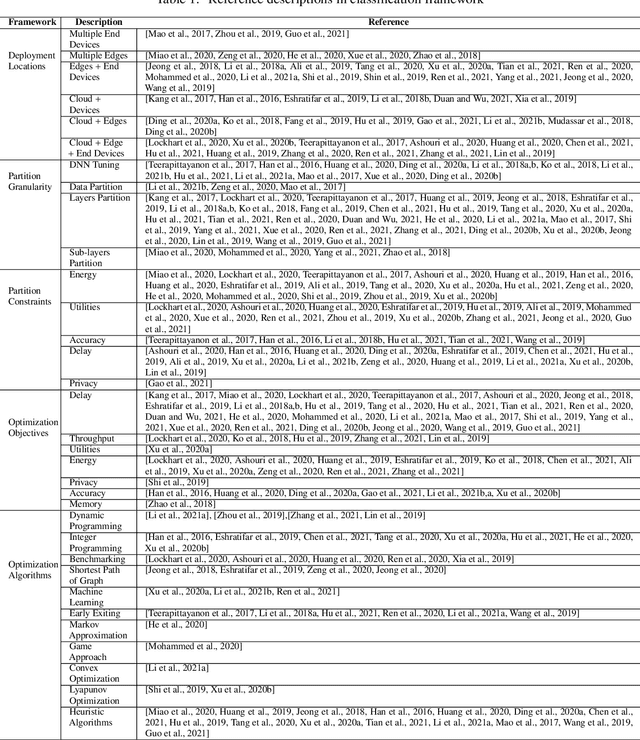

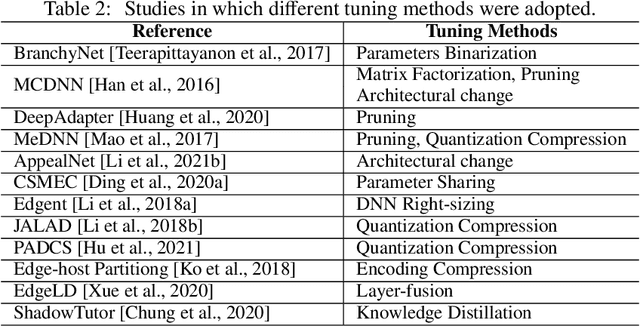
Abstract:Deep neural network (DNN) partition is a research problem that involves splitting a DNN into multiple parts and offloading them to specific locations. Because of the recent advancement in multi-access edge computing and edge intelligence, DNN partition has been considered as a powerful tool for improving DNN inference performance when the computing resources of edge and end devices are limited and the remote transmission of data from these devices to clouds is costly. This paper provides a comprehensive survey on the recent advances and challenges in DNN partition approaches over the cloud, edge, and end devices based on a detailed literature collection. We review how DNN partition works in various application scenarios, and provide a unified mathematical model of the DNN partition problem. We developed a five-dimensional classification framework for DNN partition approaches, consisting of deployment locations, partition granularity, partition constraints, optimization objectives, and optimization algorithms. Each existing DNN partition approache can be perfectly defined in this framework by instantiating each dimension into specific values. In addition, we suggest a set of metrics for comparing and evaluating the DNN partition approaches. Based on this, we identify and discuss research challenges that have not yet been investigated or fully addressed. We hope that this work helps DNN partition researchers by highlighting significant future research directions in this domain.
Who Should I Engage with At What Time? A Missing Event Aware Temporal Graph Neural Network
Jan 20, 2023Abstract:Temporal graph neural network has recently received significant attention due to its wide application scenarios, such as bioinformatics, knowledge graphs, and social networks. There are some temporal graph neural networks that achieve remarkable results. However, these works focus on future event prediction and are performed under the assumption that all historical events are observable. In real-world applications, events are not always observable, and estimating event time is as important as predicting future events. In this paper, we propose MTGN, a missing event-aware temporal graph neural network, which uniformly models evolving graph structure and timing of events to support predicting what will happen in the future and when it will happen.MTGN models the dynamic of both observed and missing events as two coupled temporal point processes, thereby incorporating the effects of missing events into the network. Experimental results on several real-world temporal graphs demonstrate that MTGN significantly outperforms existing methods with up to 89% and 112% more accurate time and link prediction. Code can be found on https://github.com/HIT-ICES/TNNLS-MTGN.
A Personalized Utterance Style (PUS) based Dialogue Strategy for Efficient Service Requirement Elicitation
Jan 07, 2023Abstract:With the flourish of services on the Internet, a prerequisite for service providers to precisely deliver services to their customers is to capture user requirements comprehensively, accurately, and efficiently. This is called the ``Service Requirement Elicitation (SRE)'' task. Considering the amount of customers is huge, it is an inefficient way for service providers to interact with each user by face-to-face dialog. Therefore, to elicit user requirements with the assistance of virtual intelligent assistants has become a mainstream way. Since user requirements generally consist of different levels of details and need to be satisfied by services from multiple domains, there is a huge potential requirement space for SRE to explore to elicit complete requirements. Considering that traditional dialogue system with static slots cannot be directly applied to the SRE task, it is a challenge to design an efficient dialogue strategy to guide users to express their complete and accurate requirements in such a huge potential requirement space. Based on the phenomenon that users tend to express requirements subjectively in a sequential manner, we propose a Personalized Utterance Style (PUS) module to perceive the personalized requirement expression habits, and then apply PUS to an dialogue strategy to efficiently complete the SRE task. Specifically, the dialogue strategy chooses suitable response actions for dynamically updating the dialogue state. With the assistance of PUS extracted from dialogue history, the system can shrink the search scope of potential requirement space. Experiment results show that the dialogue strategy with PUS can elicit more accurate user requirements with fewer dialogue rounds.
DySR: A Dynamic Representation Learning and Aligning based Model for Service Bundle Recommendation
Aug 07, 2021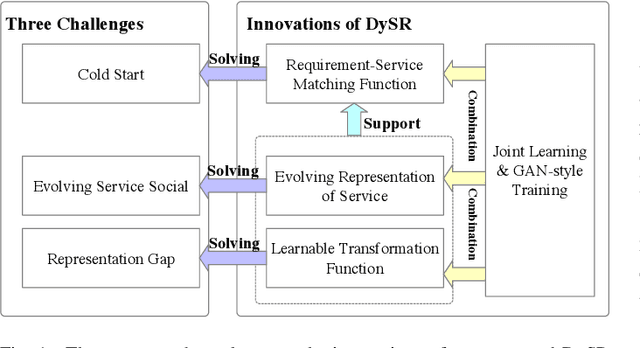
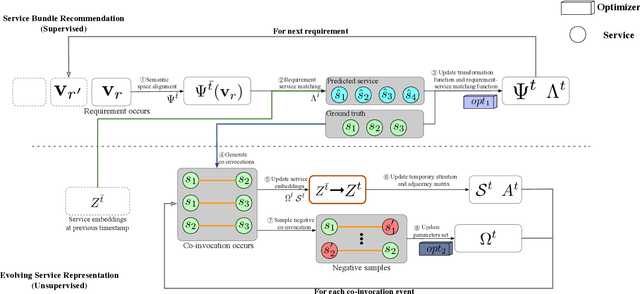
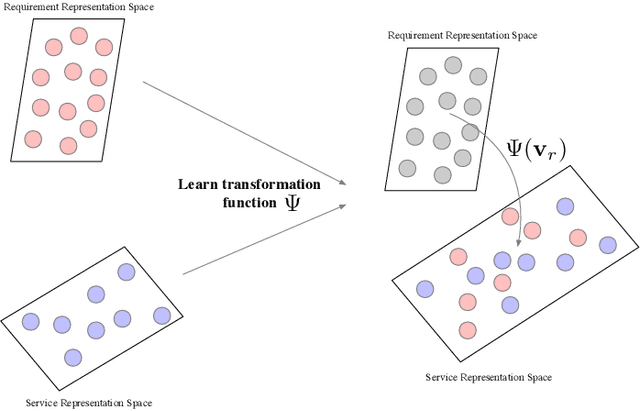
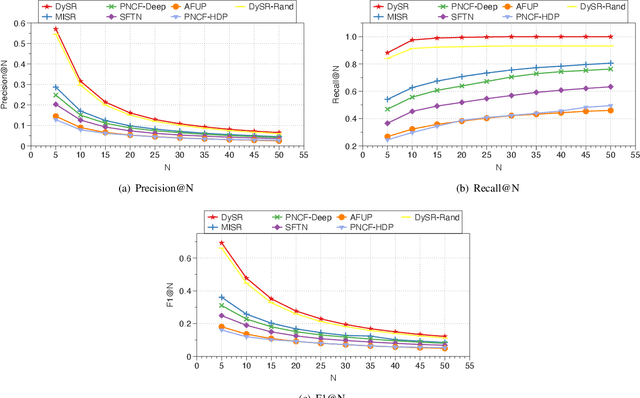
Abstract:An increasing number and diversity of services are available, which result in significant challenges to effective reuse service during requirement satisfaction. There have been many service bundle recommendation studies and achieved remarkable results. However, there is still plenty of room for improvement in the performance of these methods. The fundamental problem with these studies is that they ignore the evolution of services over time and the representation gap between services and requirements. In this paper, we propose a dynamic representation learning and aligning based model called DySR to tackle these issues. DySR eliminates the representation gap between services and requirements by learning a transformation function and obtains service representations in an evolving social environment through dynamic graph representation learning. Extensive experiments conducted on a real-world dataset from ProgrammableWeb show that DySR outperforms existing state-of-the-art methods in commonly used evaluation metrics, improving $F1@5$ from $36.1\%$ to $69.3\%$.
Learning Representation over Dynamic Graph using Aggregation-Diffusion Mechanism
Jun 03, 2021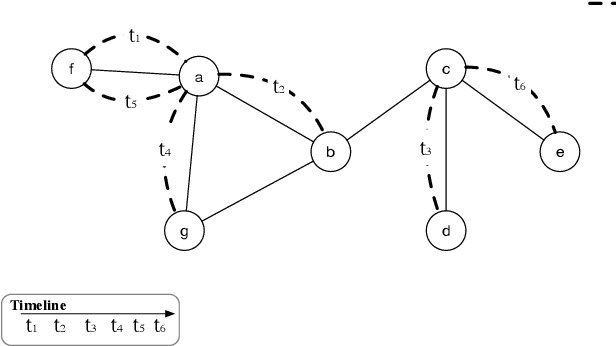
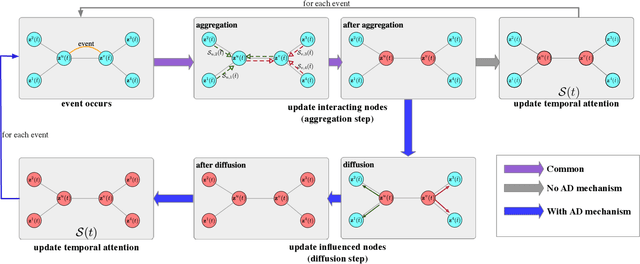
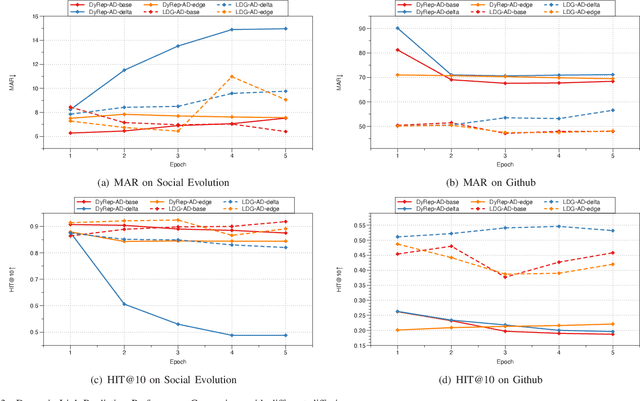
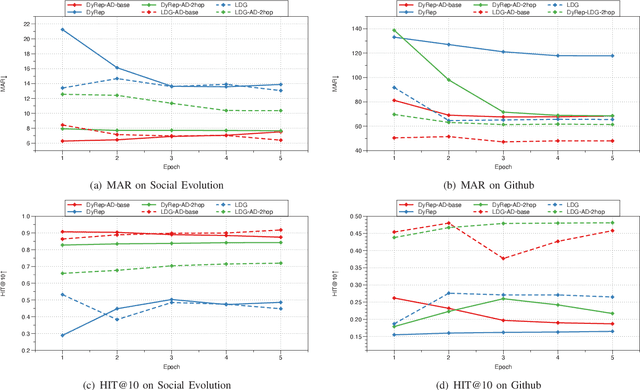
Abstract:Representation learning on graphs that evolve has recently received significant attention due to its wide application scenarios, such as bioinformatics, knowledge graphs, and social networks. The propagation of information in graphs is important in learning dynamic graph representations, and most of the existing methods achieve this by aggregation. However, relying only on aggregation to propagate information in dynamic graphs can result in delays in information propagation and thus affect the performance of the method. To alleviate this problem, we propose an aggregation-diffusion (AD) mechanism that actively propagates information to its neighbor by diffusion after the node updates its embedding through the aggregation mechanism. In experiments on two real-world datasets in the dynamic link prediction task, the AD mechanism outperforms the baseline models that only use aggregation to propagate information. We further conduct extensive experiments to discuss the influence of different factors in the AD mechanism.
 Add to Chrome
Add to Chrome Add to Firefox
Add to Firefox Add to Edge
Add to Edge